Undervalued Healthcare Stocks August 2025: 5 Long-Term Winners Trading at Deep Discounts
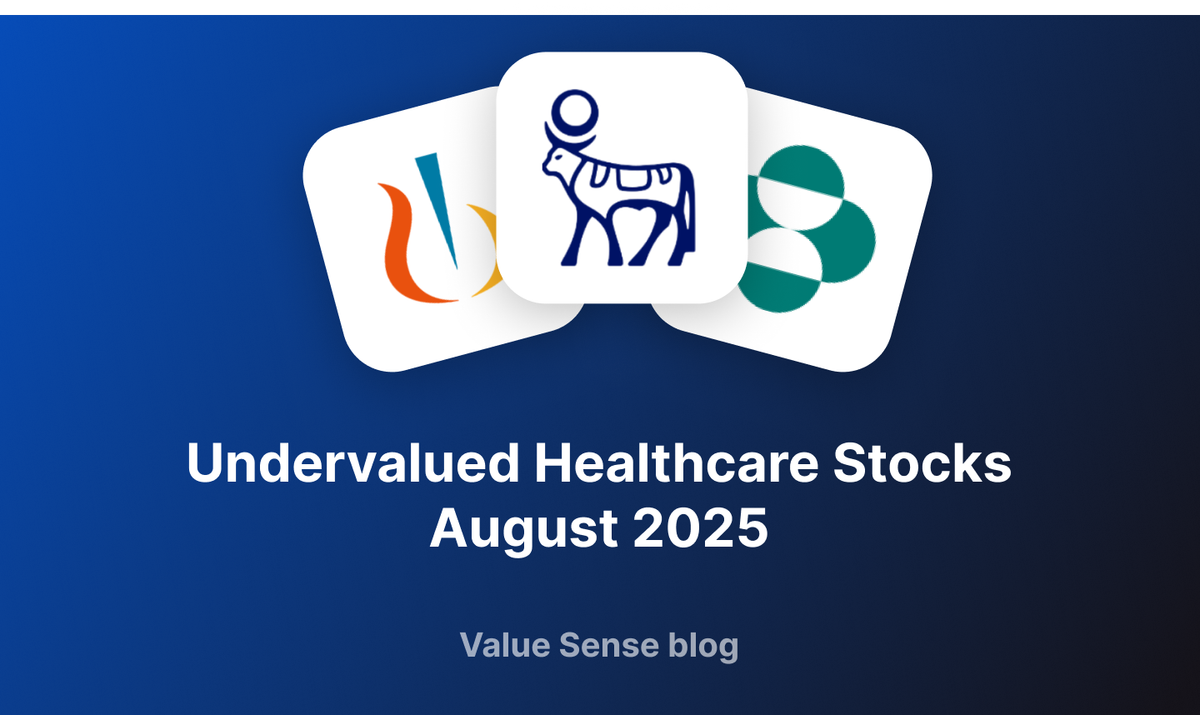
Welcome to the Value Sense Blog, your resource for insights on the stock market! At Value Sense, we focus on intrinsic value tools and offer stock ideas with undervalued companies. Dive into our research products and learn more about our unique approach at valuesense.io
Explore diverse stock ideas covering technology, healthcare, and commodities sectors. Our insights are crafted to help investors spot opportunities in undervalued growth stocks, enhancing potential returns. Visit us to see evaluations and in-depth market research.
The healthcare sector has always been a cornerstone of defensive investing, but August 2025 presents extraordinary opportunities for investors seeking undervalued healthcare stocks 2025. While tech stocks dominate headlines and valuations soar across growth sectors, some of the world's most innovative pharmaceutical and medical device companies are trading at significant discounts to their intrinsic value.
Using comprehensive ValueSense analysis, we've identified five healthcare giants that combine pharmaceutical innovation with attractive valuations. These aren't speculative biotech plays – they're established industry leaders with proven drug portfolios, strong cash generation, and clear paths to sustained growth trading well below fair value.
The convergence of an aging global population, breakthrough medical innovations, and temporary market pessimism has created a perfect storm for cheap healthcare stocks that won't stay cheap forever.
Why Healthcare Stocks Are Undervalued in 2025
The current healthcare valuation environment reflects several temporary headwinds that have created exceptional buying opportunities:
Regulatory Uncertainty: Ongoing drug pricing debates and regulatory changes have created short-term pressure on pharmaceutical valuations, despite strong underlying fundamentals.
Patent Cliff Fears: Investors remain concerned about major drug patent expirations, often overlooking robust pipeline development and successful drug launches.
Market Rotation: Capital has fled to AI and technology sectors, leaving quality healthcare companies trading at multi-year valuation lows.
Interest Rate Impact: Higher discount rates have disproportionately affected long-duration pharmaceutical assets, creating valuation disconnects for companies with strong pipeline prospects.
These factors have created an environment where medical value investing opportunities abound for patient investors willing to look beyond short-term headwinds.
5 Undervalued Healthcare Stocks: Deep Value Analysis
Novo Nordisk A/S (NVO) - Diabetes Innovation Leader
ValueSense Quality Rating: 6.6/10 | Market Cap: $250.5B
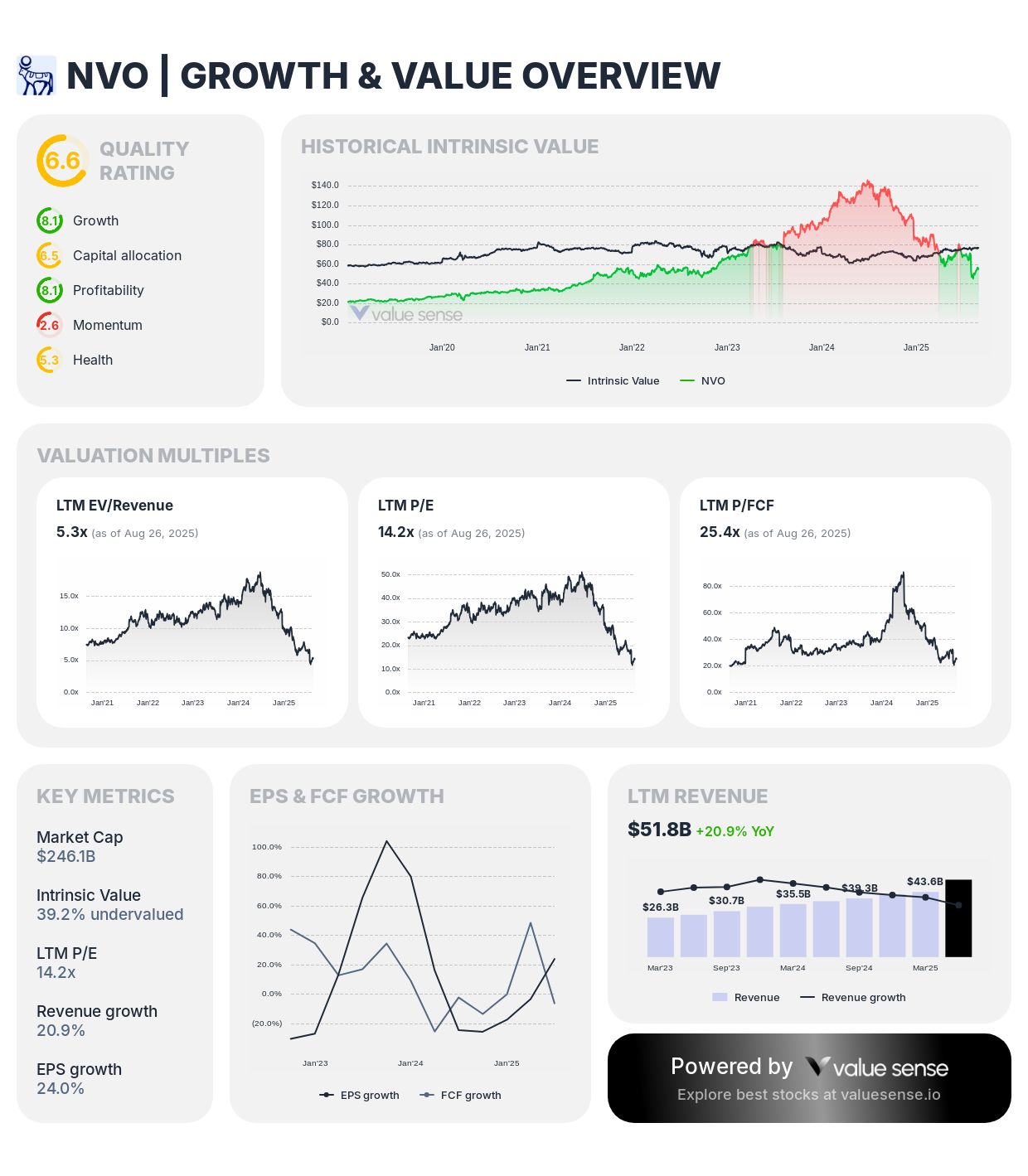
Novo Nordisk represents one of the most compelling opportunities in the diabetes and obesity treatment space, despite its large market capitalization.
- Intrinsic Value: $76.5 per share (35.7% undervalued)
- DCF Value: $61.7 (45.0% undervaluation potential)
- Ben Graham Fair Value: $100.1 (77.8% undervaluation by conservative metrics)
- Peter Lynch Fair Value: $102.6 (82.1% undervaluation)
- Revenue: DKK 311.9B demonstrating global reach in diabetes care
- Free Cash Flow: DKK 62.0B showing excellent cash conversion
- Revenue Growth: Impressive 20.9% growth driven by GLP-1 demand
- Return Metrics: Strong operational efficiency in pharmaceutical manufacturing
Investment Thesis: Novo Nordisk's Ozempic and Wegovy franchise has revolutionized diabetes and obesity treatment, creating a massive addressable market. Despite recent success, ValueSense analysis suggests the market hasn't fully recognized the long-term revenue potential from these breakthrough therapies.
Key Catalysts: Expanding obesity treatment approvals, international market penetration, and pipeline development in related metabolic disorders position NVO for sustained growth well beyond current market expectations.
Novartis AG (NVS) - Pharmaceutical Transformation Story
ValueSense Quality Rating: 7.4/10 | Market Cap: $243.6B
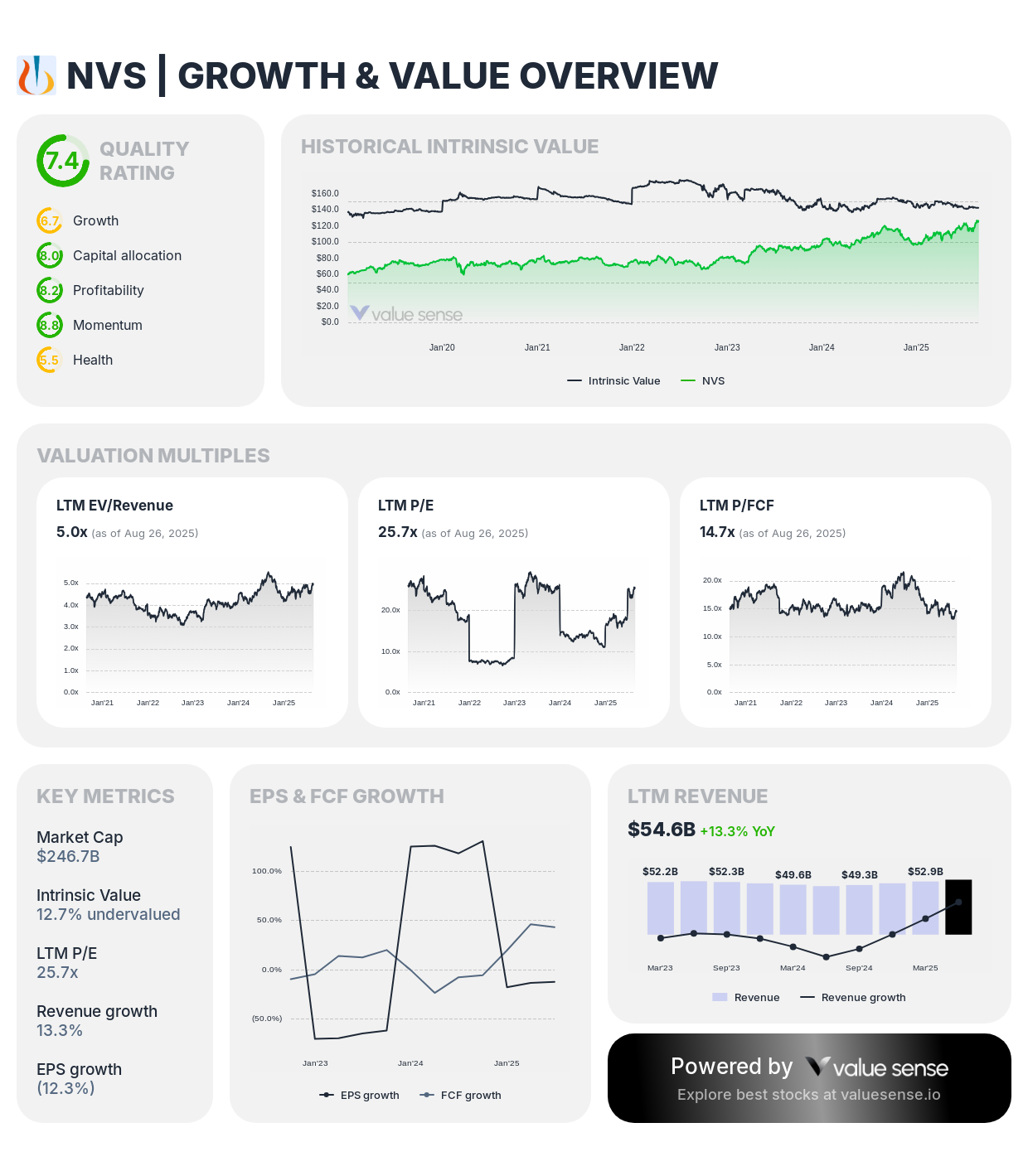
Novartis has successfully transformed from a diversified conglomerate into a focused pharmaceutical powerhouse, yet valuations remain compressed.
- Intrinsic Value: $142.6 (14.1% undervalued despite quality transformation)
- DCF Analysis: $161.2 (29.0% discount to discounted cash flow value)
- Revenue: $54.6B with focused pharmaceutical portfolio
- Free Cash Flow: $16.8B demonstrating consistent cash generation
- Earnings Yield: 3.9% competitive for large pharma
- FCF Yield: 6.9% attractive for income-focused investors
- Revenue Growth: Steady 13.3% growth from innovative drug portfolio
- P/E Ratio: 25.3x reasonable for pharmaceutical innovation leader
Strategic Position: Novartis' focus on oncology, immunology, and neuroscience has created one of the industry's strongest pipelines. The company's successful spin-offs and portfolio optimization have enhanced focus on high-value therapeutic areas.
Value Catalyst: Multiple late-stage pipeline candidates in large addressable markets could drive significant value creation as clinical data emerges and regulatory approvals materialize.
Abbott Laboratories (ABT) - Medical Device Diversification
ValueSense Quality Rating: 7.2/10 | Market Cap: $229.5B
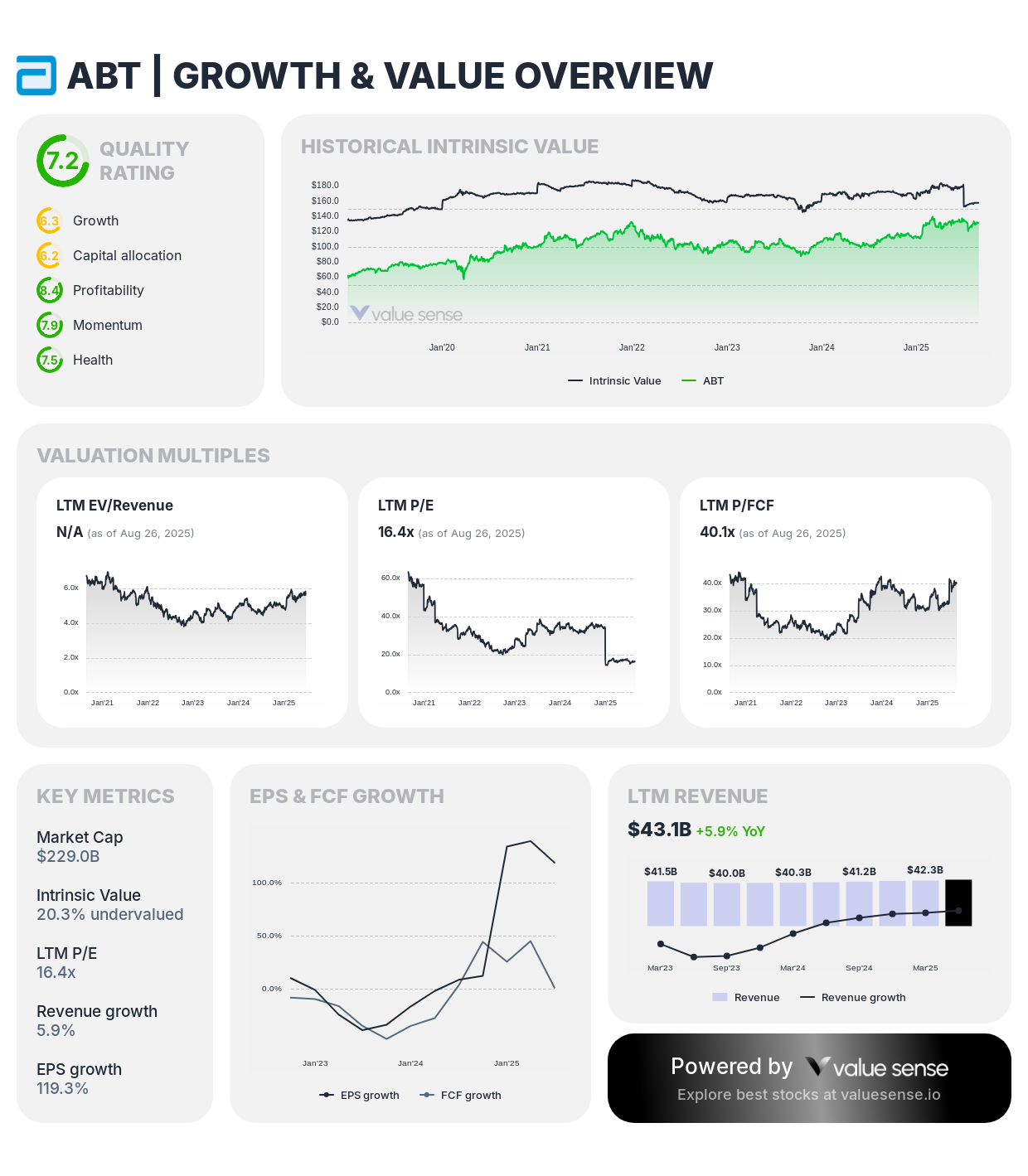
Abbott represents the ultimate diversified healthcare play, combining medical devices, diagnostics, pharmaceuticals, and nutritional products.
- Intrinsic Value: $158.2 (19.9% undervalued across multiple methodologies)
- Ben Graham Value: Shows significant overvaluation by conservative metrics (221.0%)
- Peter Lynch Value: Indicates overvaluation (178.3%), suggesting premium valuation for quality
- Revenue: $43.1B across diversified healthcare segments
- Free Cash Flow: $5.7B supporting dividend growth and R&D investment
- Revenue Growth: Solid 5.9% organic growth across business segments
- 1Y Return: Strong 18.2% demonstrating market recognition of quality
Diversification Advantage: Abbott's unique position spanning medical devices (FreeStyle glucose monitors), diagnostics, pharmaceuticals, and nutritional products provides defensive characteristics and multiple growth vectors.
Innovation Pipeline: Continuous glucose monitoring leadership, structural heart devices, and diagnostic innovations position Abbott for sustained growth in attractive end markets.
Merck & Co., Inc. (MRK) - Oncology Pipeline Powerhouse
ValueSense Quality Rating: 6.7/10 | Market Cap: $214.4B
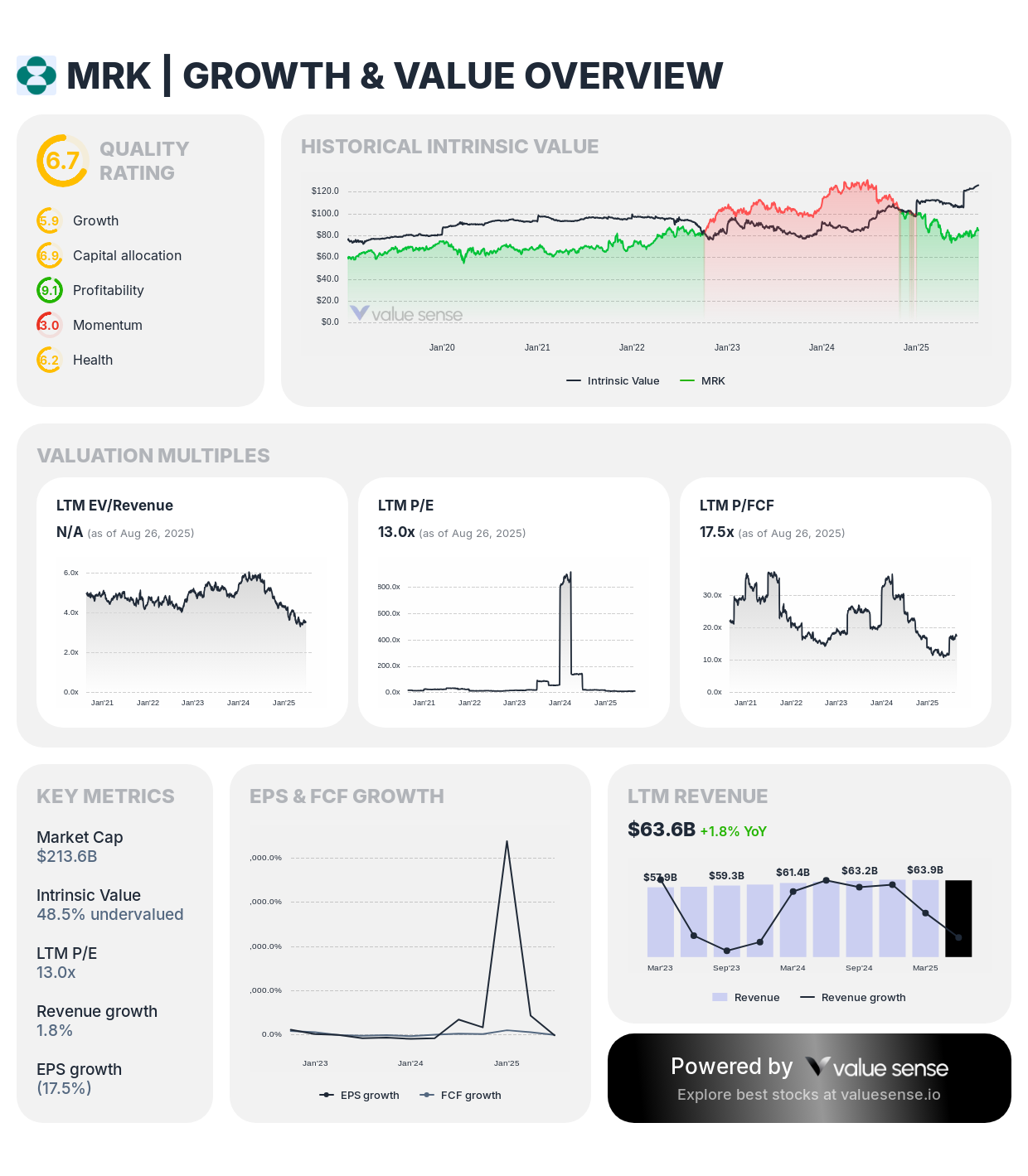
Merck's transformation into an oncology-focused pharmaceutical leader has created significant long-term value, yet current valuations suggest the market underappreciates the pipeline potential.
- Intrinsic Value: $126.1 (47.8% undervalued by fundamental analysis)
- Ben Graham Fair Value: $222.7 (161.0% undervaluation by conservative metrics)
- Peter Lynch Fair Value: $155.2 (81.9% discount to growth-adjusted value)
- Revenue: $63.6B driven by Keytruda franchise and pipeline
- Free Cash Flow: $12.2B supporting R&D investment and shareholder returns
- Revenue Growth: Modest 1.8% reflecting patent transitions and pipeline timing
- Earnings Yield: Strong 7.7% attractive for pharmaceutical sector
Keytruda Dominance: Merck's PD-1 inhibitor Keytruda has become one of the world's best-selling cancer treatments, with expanding indications continuing to drive growth.
Pipeline Depth: Beyond Keytruda, Merck maintains one of the industry's most promising oncology pipelines, with multiple late-stage candidates addressing large unmet medical needs.
Thermo Fisher Scientific Inc. (TMO) - Life Sciences Infrastructure
ValueSense Quality Rating: 6.1/10 | Market Cap: $185.5B
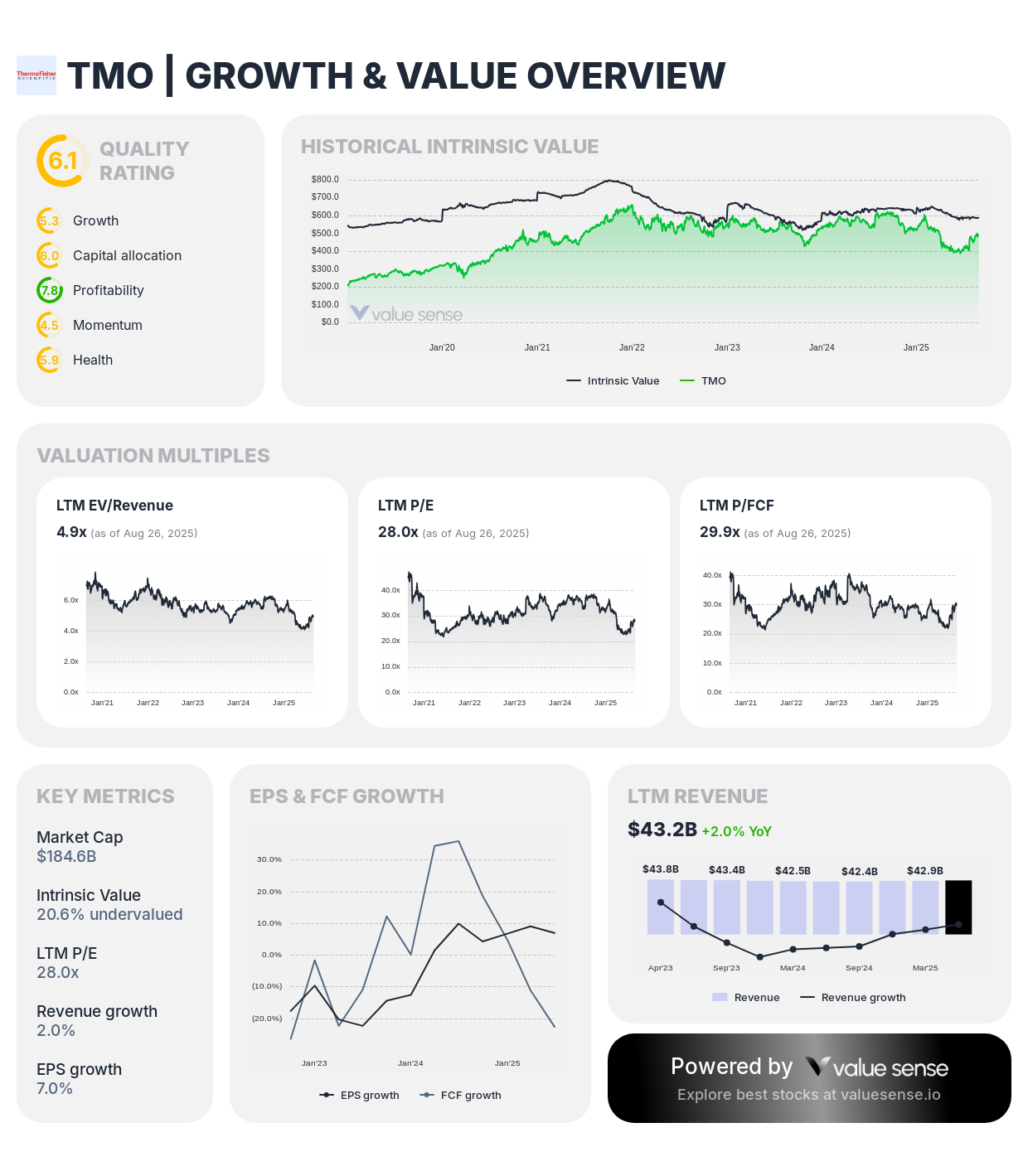
Thermo Fisher represents the "picks and shovels" approach to healthcare investing, providing essential tools and services across the entire pharmaceutical development ecosystem.
- Intrinsic Value: $595.3 (21.3% undervalued despite market leadership)
- DCF Value: $689.6 (41.0% discount to discounted cash flow analysis)
- Ben Graham Fair Value: $706.2 (43.9% undervaluation by conservative metrics)
- Revenue: $43.2B across life sciences tools and services
- Free Cash Flow: $6.2B demonstrating strong conversion and capital efficiency
- Revenue Growth: Steady 2.0% with recurring revenue characteristics
- Business Model: High-margin, recurring revenue from essential research tools
Market Position: Thermo Fisher's dominant position in analytical instruments, reagents, and contract research services provides exposure to the entire pharmaceutical innovation cycle.
Secular Trends: Aging populations, increased R&D spending, and personalized medicine trends drive long-term demand for Thermo Fisher's essential products and services.
Healthcare Sector Valuation Analysis
The comprehensive valuation analysis reveals significant disconnects between current market prices and fundamental value across our undervalued healthcare stocks 2025 selection:
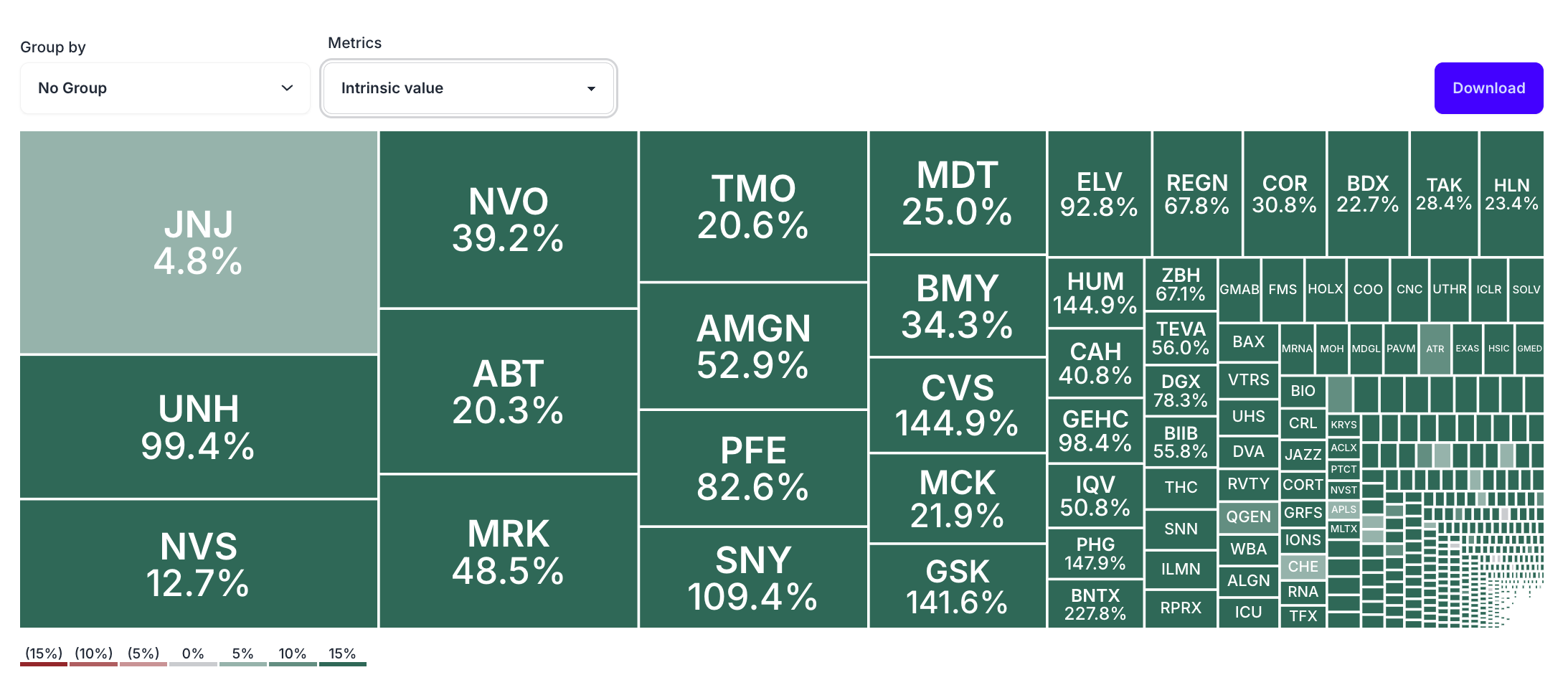
Valuation Summary Table
| Company | Ticker | Market Cap | Intrinsic Value | Undervaluation | 1Y Return | Revenue Growth | FCF Yield |
|---|---|---|---|---|---|---|---|
| Novo Nordisk | NVO | $250.5B | $76.5 | 35.7% | (58.4%) | 20.9% | 3.9% |
| Novartis AG | NVS | $243.6B | $142.6 | 14.1% | 4.9% | 13.3% | 6.9% |
| Abbott Labs | ABT | $229.5B | $158.2 | 19.9% | 18.2% | 5.9% | 2.5% |
| Merck & Co | MRK | $214.4B | $126.1 | 47.8% | (25.5%) | 1.8% | 5.7% |
| Thermo Fisher | TMO | $185.5B | $595.3 | 21.3% | (18.9%) | 2.0% | 3.3% |
Source: ValueSense Analysis, August 2025
Investment Themes Driving Healthcare Value
Aging Demographics and Chronic Disease
The global aging population represents a secular tailwind for healthcare spending:
Market Expansion: By 2030, over 1 billion people worldwide will be over 65, driving demand for chronic disease treatments, medical devices, and healthcare services.
Chronic Disease Growth: Diabetes, obesity, cardiovascular disease, and cancer rates continue rising globally, expanding addressable markets for pharmaceutical innovations.
Healthcare Infrastructure: Aging populations require more medical facilities, diagnostic equipment, and healthcare professionals, benefiting companies like Thermo Fisher and Abbott.
Pharmaceutical Innovation Cycle
Breakthrough Therapies: GLP-1 agonists (Novo Nordisk), CAR-T therapies (various), and precision oncology treatments represent paradigm shifts with massive market potential.
Pipeline Maturation: Major pharmaceutical companies have rebuilt pipelines following patent cliff periods, with late-stage candidates approaching commercialization.
Regulatory Support: Accelerated approval pathways and breakthrough therapy designations are shortening development timelines and reducing regulatory risk.
Healthcare Technology Integration
Digital Health: Wearable devices, remote monitoring, and AI-powered diagnostics are creating new revenue streams and improving patient outcomes.
Precision Medicine: Genomic sequencing, biomarker identification, and personalized treatments are enabling more effective therapies with premium pricing.
Automation and Efficiency: Laboratory automation, AI-powered drug discovery, and manufacturing innovations are improving margins and accelerating development.
Risk Factors in Healthcare Investing
Regulatory and Political Risks
Drug Pricing Pressure: Government initiatives to reduce pharmaceutical costs could impact pricing power and profit margins.
FDA Approval Risk: Clinical trial failures and regulatory delays can significantly impact valuations, particularly for pipeline-dependent companies.
Healthcare Policy Changes: Shifts in healthcare policy, insurance coverage, and reimbursement rates affect demand and profitability.
Competitive and Technology Disruption
Generic Competition: Patent expirations expose pharmaceutical companies to generic competition and revenue declines.
Biosimilar Adoption: Biological drug patents face increasing biosimilar competition, potentially eroding market share.
Technology Disruption: AI-powered drug discovery, digital therapeutics, and novel treatment modalities could disrupt traditional pharmaceutical approaches.
Economic and Market Risks
Interest Rate Sensitivity: Healthcare stocks, particularly those with long-duration cash flows, remain sensitive to interest rate changes.
Healthcare Spending Cycles: Economic downturns can impact elective procedures, capital equipment purchases, and healthcare utilization.
Currency Exposure: Multinational healthcare companies face foreign exchange risk from international operations.
Building a Healthcare Value Portfolio
Core Holdings Strategy
Large-Cap Stability: Focus on established pharmaceutical giants like Novartis and Merck for portfolio stability and dividend income.
Innovation Exposure: Include companies like Novo Nordisk and Abbott for exposure to breakthrough therapies and medical device innovation.
Infrastructure Plays: Add Thermo Fisher for "picks and shovels" exposure to the entire pharmaceutical development ecosystem.
Diversification Approach
Therapeutic Area Spread: Balance oncology (Merck), metabolic diseases (Novo Nordisk), and diversified portfolios (Novartis, Abbott).
Geographic Exposure: Include European (Novo Nordisk, Novartis) and U.S. (Abbott, Merck, Thermo Fisher) companies for geographic diversification.
Business Model Mix: Combine pharmaceutical R&D, medical devices, and life sciences tools for comprehensive healthcare exposure.
Timing and Entry Strategy
Dollar-Cost Averaging: Given healthcare volatility, systematic accumulation can reduce timing risk while building positions in quality companies.
Catalyst-Based Buying: Major clinical trial results, FDA approvals, and product launches can create entry opportunities.
Value Discipline: Focus on companies trading below intrinsic value with strong competitive positions and secular growth drivers.
Long-Term Healthcare Investment Outlook
Demographic Tailwinds
The healthcare sector benefits from powerful demographic trends that support long-term growth:
Global Aging: Worldwide population over 65 expected to double by 2050, driving healthcare demand across all segments.
Emerging Market Growth: Rising healthcare spending in developing countries creates massive market expansion opportunities.
Chronic Disease Prevalence: Increasing rates of diabetes, obesity, and cardiovascular disease expand addressable markets for pharmaceutical interventions.
Innovation Acceleration
Scientific Breakthroughs: Advances in genomics, immunotherapy, and precision medicine are creating entirely new therapeutic categories.
Technology Integration: AI, machine learning, and digital health technologies are improving drug discovery efficiency and patient outcomes.
Manufacturing Innovation: Continuous manufacturing, automated production, and quality systems are reducing costs and improving reliability.
Market Structure Evolution
Consolidation Opportunities: Industry consolidation continues creating synergies and market leadership positions.
Specialty Focus: Companies are increasingly focusing on high-value therapeutic areas with limited competition and premium pricing.
Value-Based Care: Healthcare payment models are shifting toward outcomes-based reimbursement, favoring effective treatments and innovative delivery models.
Conclusion: Healthcare's Value Renaissance
The analysis reveals that undervalued healthcare stocks 2025 represent some of the most compelling long-term investment opportunities available today. Companies like Novo Nordisk, Novartis, Abbott, Merck, and Thermo Fisher combine pharmaceutical innovation with attractive valuations rarely seen in the healthcare sector.
The convergence of demographic tailwinds, scientific breakthroughs, and temporary market pessimism has created valuation disconnects that patient investors can exploit. These aren't speculative biotech plays – they're established industry leaders with proven business models, strong cash generation, and clear competitive advantages trading well below intrinsic value.
While short-term headwinds around drug pricing, regulatory uncertainty, and market rotation persist, the long-term investment thesis for healthcare remains compelling. An aging global population, breakthrough medical innovations, and expanding healthcare access create secular growth drivers that support sustained value creation.
For investors seeking cheap healthcare stocks with long-term appreciation potential, the current environment provides exceptional entry points into quality companies that will likely benefit from decades of demographic-driven growth. The key is identifying companies with strong competitive positions, innovative pipelines, and valuation discounts that provide margin of safety while waiting for market recognition.
The healthcare sector's defensive characteristics, combined with innovation-driven growth potential, make it an essential component of diversified portfolios. Current valuations provide an opportunity to build positions in industry leaders at prices that may not be available as demographic trends accelerate and market sentiment improves.
Explore More Investment Opportunities
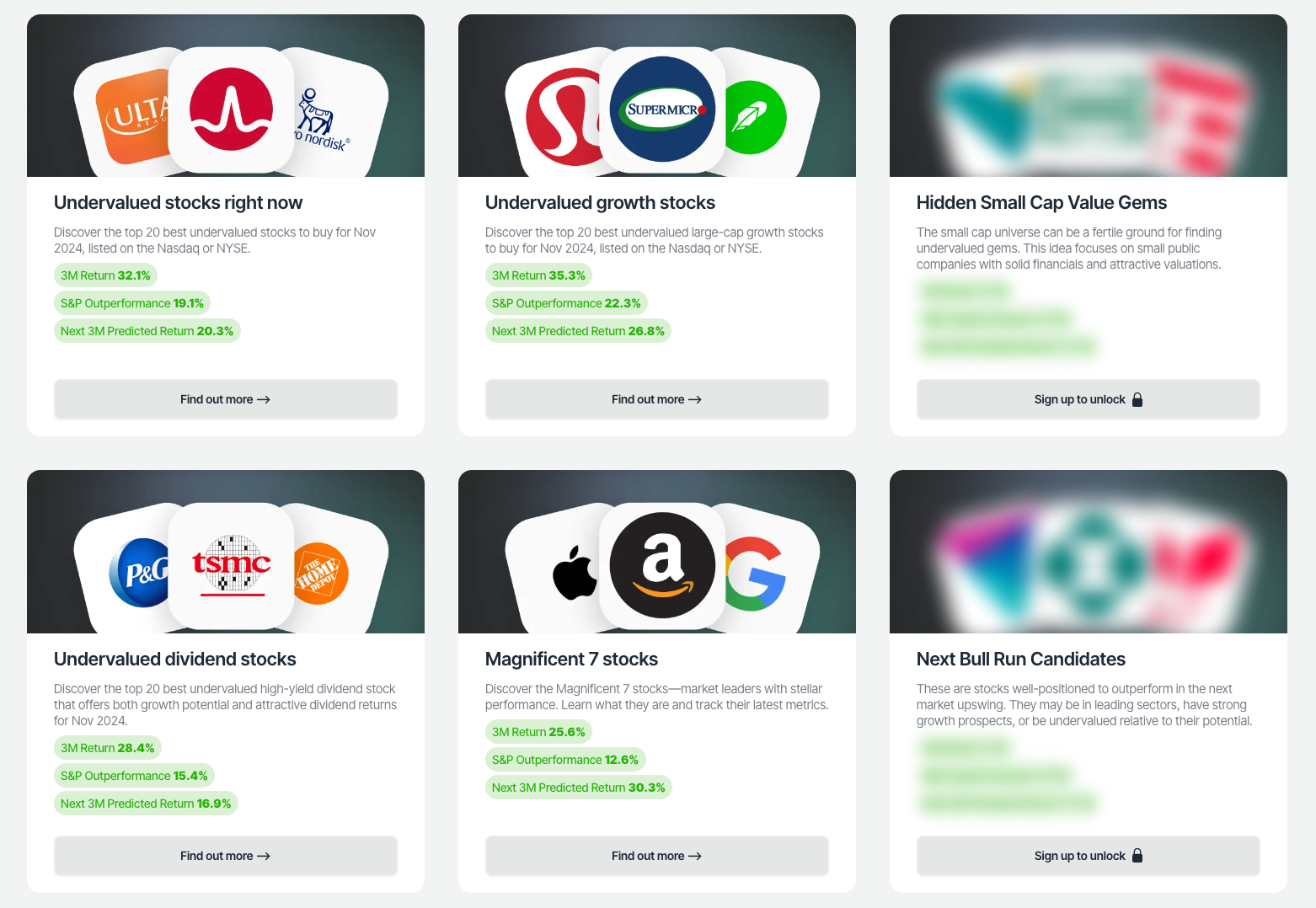
For investors seeking undervalued companies with high fundamental quality, our analytics team provides curated stock lists:
📌 50 Undervalued Stocks (Best overall value plays for 2025)
📌 50 Undervalued Dividend Stocks (For income-focused investors)
📌 50 Undervalued Growth Stocks (High-growth potential with strong fundamentals)
🔍 Check out these stocks on the Value Sense platform for free!
More Articles You Might Like
📖 Coca-Cola Stock Analysis: Why KO Is the Ultimate Undervalued Dividend King
📖 Undervalued Energy Stocks for September 2025
📖 8 Small Cap Undervalued Stocks Worth Your Attention
FAQ: Undervalued Healthcare Stocks Investment
Q: Are healthcare stocks really undervalued in 2025, or are lower valuations justified by industry challenges?
A: ValueSense analysis shows genuine undervaluation across major healthcare names, with companies like Merck trading 47.8% below intrinsic value and Novo Nordisk at 35.7% discounts. While industry challenges around drug pricing and regulatory uncertainty exist, current valuations appear to overly discount long-term growth prospects from demographic trends, pipeline innovations, and market expansion opportunities. The combination of defensive characteristics and innovation-driven growth supports higher valuations than current market levels.
Q: Which healthcare subsector offers the best value opportunities in 2025?
A: Pharmaceutical companies currently offer the most compelling value, with established players like Merck and Novartis trading at significant discounts despite strong pipelines and cash generation. However, diversified healthcare companies like Abbott and life sciences tools providers like Thermo Fisher offer attractive risk-adjusted returns with more predictable revenue streams. The key is balancing pharmaceutical innovation upside with the stability of medical device and tools businesses.
Q: How do I evaluate the sustainability of healthcare companies' competitive advantages?
A: Focus on companies with strong intellectual property portfolios, regulatory moats, and market leadership positions. Novo Nordisk's GLP-1 franchise, Merck's oncology pipeline, and Thermo Fisher's essential laboratory tools demonstrate sustainable competitive advantages. Look for companies with high switching costs, recurring revenue models, and continuous innovation capabilities that can maintain pricing power and market share over time.
Q: What are the biggest risks when investing in undervalued healthcare stocks?
A: Primary risks include regulatory approval failures for pipeline drugs, patent cliff exposure as major drugs lose exclusivity, and drug pricing pressure from government initiatives. Additionally, clinical trial failures can significantly impact valuations, particularly for pipeline-dependent companies. However, diversified healthcare portfolios across therapeutic areas and business models can mitigate these risks while maintaining upside exposure to breakthrough innovations.
Q: How should healthcare stocks fit into a broader investment portfolio?
A: Healthcare stocks typically represent 10-15% of diversified equity portfolios, providing defensive characteristics and long-term growth exposure. Within healthcare allocation, balance pharmaceutical innovation (40-50%) with medical devices (25-30%) and life sciences tools (20-25%) for optimal risk-adjusted returns. The sector's low correlation with technology and cyclical sectors makes it valuable for portfolio diversification, while demographic tailwinds support long-term appreciation regardless of broader market conditions.
